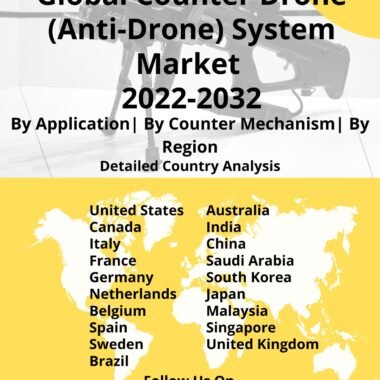Description
Global Defense Telemetry Market
Frequently Asked Questions of Defense Telemetry Market
The in-situ gathering of measurements or other data at distant locations and its automatic transmission to receiving apparatus (telecommunication) for monitoring is known as telemetry. The name comes from the Greek words tele, which means distant, and metron, which means measure. Telecommand, the opposite of telemetry, is required by systems that require outside information and commands in order to function. The term encompasses data transferred over a variety of media, including a telephone or computer network, an optical link, or other wired communications like power line carriers, even though it most often refers to wireless data transfer mechanisms (such as using radio, ultrasonic, or infrared systems). Many contemporary telemetry systems use SMS to receive and transmit telemetry data, taking advantage of the accessibility and affordability of GSM networks.
A set of measuring instruments, an encoder that converted instrument readings into analogue or digital signals, a modulator, and a wireless transmitter with an antenna made up a telemetry transmitter. An antenna, some radio-frequency (RF) amplifiers, a demodulator, and recording equipment made up the receiver. The information collected was processed and stored using mainframe computers. In what is known as the Internet of Things today, telemetry applications include collecting and transferring data from sensors found in cars, smart meters, power sources, robots, and even wildlife (IoT).
Telemetry gear is an essential component of the rocket range assets used in rocketry to track the location and condition of a launch vehicle and establish range safety flight termination criteria (Range purpose is for public safety). Extreme environmental factors (temperature, acceleration, and vibration), energy supply, antenna alignment, and signal travel time (across large distances, like in spaceflight), are among the issues. Almost all modern aircraft, missiles, and spacecraft carry wireless telemetry systems while being tested. During flight tests, aeronautical mobile telemetry is utilized to protect the safety of the pilots and those on the ground. The main source of real-time measurement and status information supplied during the testing of crewed and uncrewed aircraft is telemetry from an on-board flight test instrumentation system.
Major factors driving Defense Telemetry Market Growth
It is essential to update and refurbish aircrafts to increase safety and reduce downtime. Modernizing the airspace has advantages such as better routing choices, higher efficiency, and improved pilot communication. To successfully communicate with air traffic controllers, perform multidimensional aircraft tracking, and enhance navigation by producing images of the topography of the forward external scene, new technologies and components must be installed. When effectively carried out, these modernization initiatives contribute to fuel savings, improved air quality, and a decrease in carbon emissions.
Increasing demand for new platforms will be driving the growth of the defense telemetry market size. There is increasing procurement of anti-tank missile, UAVs and armored vehicles. This factor will also drive the growth of defense telemetry market size.
Trends influencing the Defense-Telemetry Market Size
Defense telemetry market trends, due to mass production and the integration of circuits into a single PCB, the price of electronic components has decreased dramatically. As a result, low-cost telemetry system and component production is now possible. Defense telemetry market analysis, due to their effectiveness, dependability, and cost, the antennas, a telemetry component, are utilized extensively throughout numerous industries. Defense telemetry market trends, the overall size of antennas is being reduced through the large-scale downsizing of electrical components, allowing for their simple integration into constrained locations. Additionally, it leads to reduced fuel and electricity use. Additionally, it supports manufacturers in their efforts to make UAVs and other spacecraft smaller.
Defense-Telemetry Market Forecast & Dynamics
Defense telemetry market forecast, the increase in defense spending will encourage procurement of anti-submarine warfare systems and related systems to step up their production volumes and improve their quality, thereby enhancing competition in the global markets. Defense telemetry market analysis, procurement will also be driven by prevailing geo political conditions in Europe and the Asia Pacific and increasing use of submarines for surveillance and intelligence gathering.
Defense Telemetry Market Analysis for Recent Developments
Defense telemetry market reports, on June 28, 2022, the Indian Army and the Defence Research and Development Organization (DRDO) successfully tested a locally developed Laser-Guided Anti-Tank Guided Missile (ATGM) from the Main Battle Tank (MBT) Arjun at the KK Ranges with assistance from the Armoured Corps Centre & School (ACC&S) Ahmednagar. The ATGM, according to the DRDO, targeted the target with textbook accuracy and eliminated it at close ranges. Telemetry systems captured the missile’s successful flight performance. The physical characteristics of subsystems as well as navigational information obtained and recorded through telemetry are necessary for evaluating medium and long range missiles. The telemetry devices installed at the launch site ensure that data is received for the flight path’s launch and mid-course phases.
Defense telemetry market reports, under a $3.3 billion contract, Northrop Grumman will build the Ground-Based Midcourse Defense (GMD) Weapon System. The Northrop Grumman Mission Systems division in Huntsville, Alabama, may receive a five-year, $3.3 billion contract to field the next generation of the GMD Weapon System, according to MDA officials. The GMD is a U.S. anti-ballistic missile system designed to stop approaching warheads in midcourse, or roughly midway between launch and impact. With interceptors and sensors on land, at sea, and in space, the GMD is deployed at Fort Greely, Alabama, and Vandenberg Space Force Base, California.
The market is at the forefront of providing critical data acquisition and transmission solutions for military applications, revolutionizing the way armed forces gather and analyze information. Telemetry systems are instrumental in monitoring and transmitting real-time data on various aspects of defense operations, including missile testing, aircraft performance, and battlefield surveillance. The market is experiencing significant growth driven by the increasing complexity of defense systems and the need for precise, timely, and secure data for decision-making. Technological advancements in telemetry systems, such as the integration of advanced sensors, encryption technologies, and data analytics, are enhancing the capabilities of defense telemetry. These innovations contribute to improved accuracy, reliability, and efficiency in collecting and transmitting data from diverse military platforms.
Geopolitical considerations and the modernization of defense capabilities are key factors influencing the market dynamics. Nations are investing in defense telemetry solutions to enhance the performance, safety, and effectiveness of their military assets, ranging from missiles and unmanned aerial vehicles to ground vehicles. The global Defense Telemetry market in 2023 represents a convergence of cutting-edge technologies and strategic imperatives, ensuring that defense forces have access to reliable and comprehensive data for mission-critical operations in an ever-evolving security landscape.
![Global_Defense_Telemetry_Market_2024-2034[1] Global_Defense_Telemetry_Market_](https://aviationanddefensemarketreports.com/wp-content/uploads/2022/08/Global_Defense_Telemetry_Market_2024-20341.jpg)






